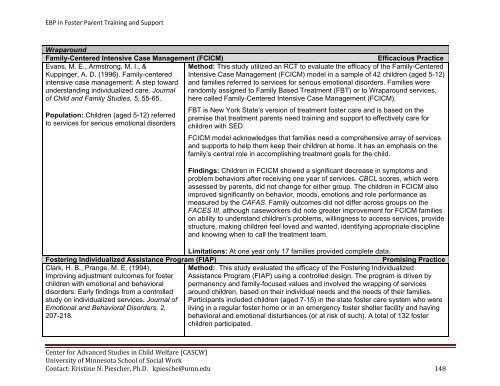Evidence-Based Practice in Foster Parent Training and Support ...
Evidence-Based Practice in Foster Parent Training and Support ...
Evidence-Based Practice in Foster Parent Training and Support ...
You also want an ePaper? Increase the reach of your titles
YUMPU automatically turns print PDFs into web optimized ePapers that Google loves.
EBP <strong>in</strong> <strong>Foster</strong> <strong>Parent</strong> Tra<strong>in</strong><strong>in</strong>g <strong>and</strong> <strong>Support</strong>WraparoundFamily-Centered Intensive Case Management (FCICM) Efficacious <strong>Practice</strong>Evans, M. E., Armstrong, M. I., &Method: This study utilized an RCT to evaluate the efficacy of the Family-CenteredKupp<strong>in</strong>ger, A. D. (1996). Family-centered Intensive Case Management (FCICM) model <strong>in</strong> a sample of 42 children (aged 5-12)<strong>in</strong>tensive case management: A step toward <strong>and</strong> families referred to services for serious emotional disorders. Families wereunderst<strong>and</strong><strong>in</strong>g <strong>in</strong>dividualized care. Journal r<strong>and</strong>omly assigned to Family <strong>Based</strong> Treatment (FBT) or to Wraparound services,of Child <strong>and</strong> Family Studies, 5, 55-65. here called Family-Centered Intensive Case Management (FCICM).Population: Children (aged 5-12) referredto services for serious emotional disordersFBT is New York State’s version of treatment foster care <strong>and</strong> is based on thepremise that treatment parents need tra<strong>in</strong><strong>in</strong>g <strong>and</strong> support to effectively care forchildren with SED.FCICM model acknowledges that families need a comprehensive array of services<strong>and</strong> supports to help them keep their children at home. It has an emphasis on thefamily’s central role <strong>in</strong> accomplish<strong>in</strong>g treatment goals for the child.F<strong>in</strong>d<strong>in</strong>gs: Children <strong>in</strong> FCICM showed a significant decrease <strong>in</strong> symptoms <strong>and</strong>problem behaviors after receiv<strong>in</strong>g one year of services. CBCL scores, which wereassessed by parents, did not change for either group. The children <strong>in</strong> FCICM alsoimproved significantly on behavior, moods, emotions <strong>and</strong> role performance asmeasured by the CAFAS. Family outcomes did not differ across groups on theFACES III, although caseworkers did note greater improvement for FCICM familieson ability to underst<strong>and</strong> children’s problems, will<strong>in</strong>gness to access services, providestructure, mak<strong>in</strong>g children feel loved <strong>and</strong> wanted, identify<strong>in</strong>g appropriate discipl<strong>in</strong>e<strong>and</strong> know<strong>in</strong>g when to call the treatment team.Limitations: At one year only 17 families provided complete data.<strong>Foster</strong><strong>in</strong>g Individualized Assistance Program (FIAP) Promis<strong>in</strong>g <strong>Practice</strong>Clark, H. B., Prange, M. E. (1994),Method: This study evaluated the efficacy of the <strong>Foster</strong><strong>in</strong>g IndividualizedImprov<strong>in</strong>g adjustment outcomes for foster Assistance Program (FIAP) us<strong>in</strong>g a controlled design. The program is driven bychildren with emotional <strong>and</strong> behavioral permanency <strong>and</strong> family-focused values <strong>and</strong> <strong>in</strong>volved the wrapp<strong>in</strong>g of servicesdisorders: Early f<strong>in</strong>d<strong>in</strong>gs from a controlled around children, based on their <strong>in</strong>dividual needs <strong>and</strong> the needs of their families.study on <strong>in</strong>dividualized services. Journal of Participants <strong>in</strong>cluded children (aged 7-15) <strong>in</strong> the state foster care system who wereEmotional <strong>and</strong> Behavioral Disorders, 2, liv<strong>in</strong>g <strong>in</strong> a regular foster home or <strong>in</strong> an emergency foster shelter facility <strong>and</strong> hav<strong>in</strong>g207-218.behavioral <strong>and</strong> emotional disturbances (or at risk of such). A total of 132 fosterchildren participated.Center for Advanced Studies <strong>in</strong> Child Welfare (CASCW)University of M<strong>in</strong>nesota School of Social WorkContact: Krist<strong>in</strong>e N. Piescher, Ph.D. kpiesche@umn.edu 148
















